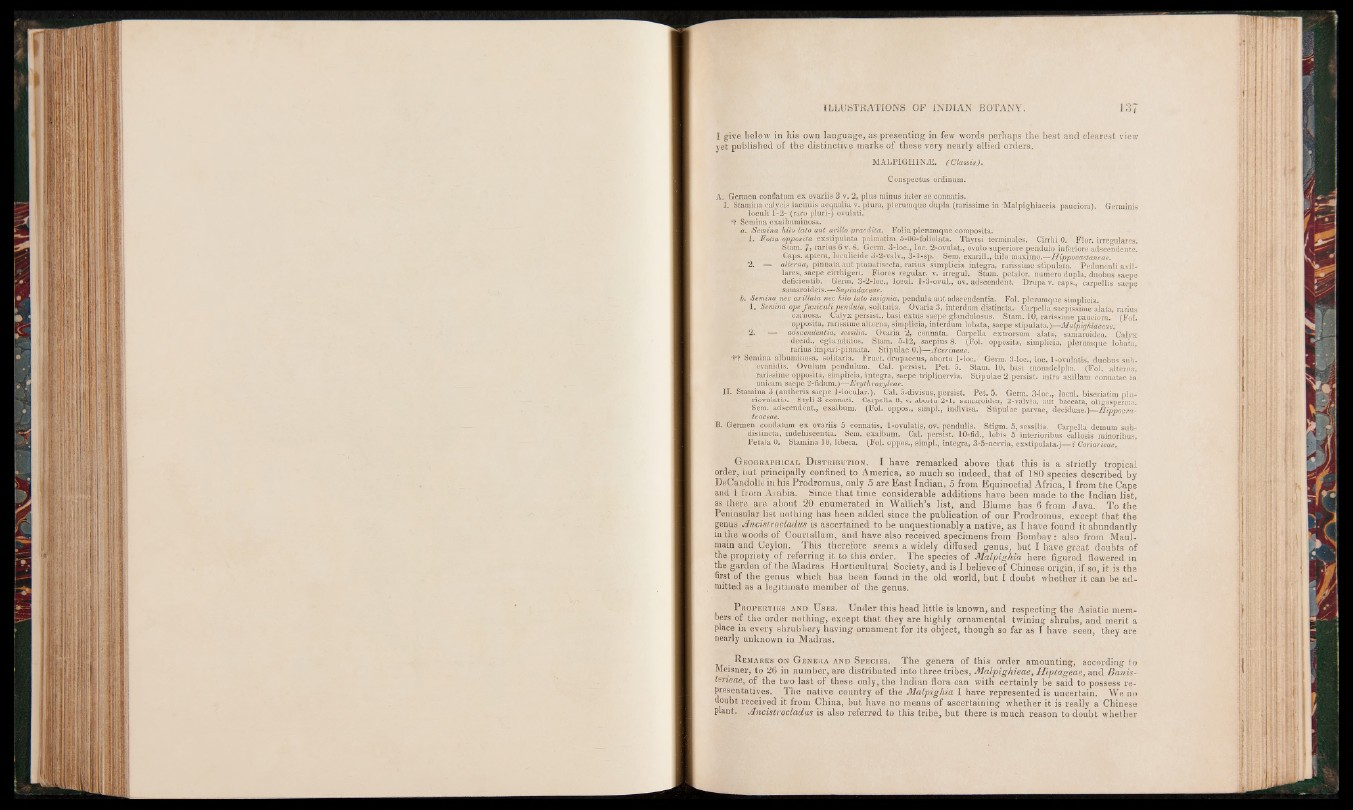
I give below in his own language, as presenting in few words perhaps the best and clearest view
yet published of the distinctive marks of these very nearly allied orders.
MALPIGHINiE. ( Classis) .
Conspectus ordinum.
A. Germen conflatum ex ovariis 3 v. 2, plus minus inter se connatis.
I. Stamina calycis laciniis aequalia v. plura, plerumque dupla (rarissime in Malpighiaceis pauciora). Germinis
' loculi 1-2- (raro pluri-) ovulati.
i* Semina exalbuminosa.
a. Semina hilo lato aut arillo praedita. Folia plerumque composita.
1. Folia opposita exstipulata palmatim o-OO-foliolata. Thyrsi terminates. Cirrhi 0. Flor. irregulares.
Stam. 7, rarius 6 v. 8. Germ. 3-loc., loc. 2-ovulat., ovulo superiore pendulo inferiore adscendentc.
Caps, aptera, loculicide 3-2-valv., 3-1-sp. Sem. exarill., hilo maximo.—Hippocastaneae.
2. — alterna, pinnata aut pinnatisecta, rarius simplicia integra, rarissime stipulata. Pedunculi axillares,
saepe cirrhigeri. Flores regular, v. irregul. Stam. petalor. numero dupla, duobus saepe
deficientib. Germ. 3-2-ioc., locul. 1-3-ovul., ov. adscendent. Drupa v. caps., carpellis saepe
samaroideis.—Sapindaceae.
b. Semina nec arillata nec hilo lato insignia, pendula aut adscendentia. Fol. plerumque simplicia.
1. Semina ope fu n ic u li pendula, solitaria. Ovaria 3, inte'rdum distincta.- Carpella saepissime alata, rarius
carnosa. Calyx persist., basi extus saepe glandulosus. Stam. 10, rarissime pauciora. (Fol.
opposita, rarissime alterna, simplicia, interdum lobata, saepe stipulata.)—Malpighiaceae.
2. — adscendentia, sessilia. Ovaria 2, connata. Carpella extrorsum alata, samaroidea. Calyx
decid., eglandulos. Stam. 5-12, saepius 8. (Fol. opposita, simplicia, plerumque lobata,
rarius impari-pinnata. Stipulae 0.)—Acerineae.
t f Semina albuminosa, Solitaria. Fruct. drupaceus, abortu 1-loc.''’ Germ. 3-loc., loc. 1-ovulatis, duobus sub-
- evanidis. Ovulum pendulum. Cal. persist. Pet. 5. Stam. 10, basi monadelpha. (Fol. alterna,
rarissime opposita, simplicia, integra, saepe triplinervia. Stipulae 2 persist, intra axillam connatae in
unicam saepe 2-fidam.)—Erythroxyleae.
II. Stamina 3 (anlheris saepe 1-locular.). Cal. 5-divisus, persist. Pet. 5. Germ. 3-loc., locul. biseriatim pluriovulatis.
Styli 3 connati. Carpella 3, v. abortu 2-1, samaroidea, 2-valvia, aut baccata, oligosperma.
Sera, adscendent., exalbum. (Fol. oppos., simpl., indivisa. Stipulae parvae,, deciduae.)—Hippocra-
. teaceae. ...
B. Germen conflatum ex ovariis 5 connatis, 1-ovulatis, ov. pendulis. Stigm. 5, sessilia. Carpella demum subdistincta,
indehiscentia. Sem. exalbum. Cal. persist. 10-fid., lobis 5 interioribus callosis minoribus.
Fetal a 0. Stamina 10, libera., (Fol. oppos., simpl., integra, 3-5-nervia, exstipulata.)— ? Coriarieae.
G eographical D istribution. I have remarked above that this is a strictly tropical
order, but principally confined to America, so much so indeed, that of 180 species described by
DeCandolle in his Prodromus, only 5 are East Indian, 5 from Equinoctial Africa, 1 from the Cape
and 1 from Arabia. Since that time considerable additions have been made to the Indian list,
as there are about 20 enumerated in Wallich’s list, and Blume has 6 from Java. To the
Peninsular list nothing has been added since the publication of our Prodromus, except that the
genus Ancistrocladus is ascertained to be unquestionably a native, as I have found it abundantly
in the woods of Courtallum, and have also received specimens from Bombay: also from Maul-
main and Ceylon. This therefore seems a widely diffused genus, but I have great doubts of
the propriety of referring it to this order. The species of Malpighia here figured flowered in
the garden of the Madras Horticultural Society, and is I believe of Chinese origin, if so, it is the
first of the genus which has been found in the old world, but I doubt whether it can be admitted
as a legitimate member of the genus.
P roperties and Uses. Under this head little is known, and respecting the Asiatic members
of the order nothing, except that they are highly ornamental twining shrubs, and merit a
place in every shrubbery having ornament for its object, though so far as I have seen, they are
nearly unknown in Madras.
Remarks on G enera and Species. The genera of this order amounting, according to
Meisner, to 26 in number, are distributed into three tribes, Malpighieae, Hiptageae, and Banis-
terieae, of the two last of these only, the Indian flora can with certainly be said to possess representatives.
The native country of the Malpighia I have represented is uncertain. We no
doubt received it from China, but have no means of ascertaining whether it is really a Chinese
plant. Ancistrocladus is also referred to this tribe, but there is much reason to doubt whether